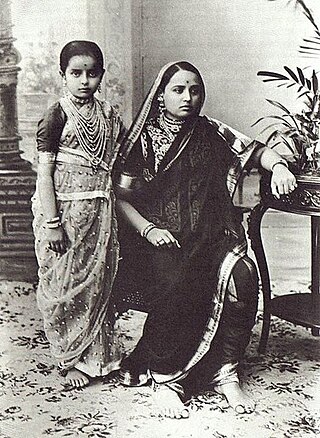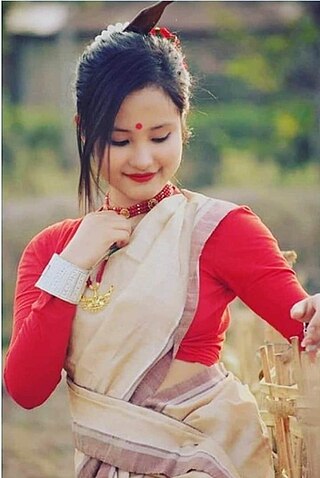
Riha is part of a three piece Assamese traditional garment worn with the Mekhela chador. It forms a part of the bridal trousseau for most Assamese brides these days. Riha, mekhela sador and traditional silk wearing are of Boro origin. [1]

Riha is part of a three piece Assamese traditional garment worn with the Mekhela chador. It forms a part of the bridal trousseau for most Assamese brides these days. Riha, mekhela sador and traditional silk wearing are of Boro origin. [1]

A sari is a women's garment from the Indian subcontinent, that consists of an un-stitched stretch of woven fabric arranged over the body as a robe, with one end tied to the waist, while the other end rests over one shoulder as a stole (shawl), sometimes baring a part of the midriff. It may vary from 4.1 to 8.2 metres in length, and 60 to 120 centimetres in breadth, and is form of ethnic wear in India, Pakistan, Bangladesh, Sri Lanka and Nepal. There are various names and styles of sari manufacture and draping, the most common being the Nivi style. The sari is worn with a fitted bodice commonly called a choli and a petticoat called ghagra, parkar, or ul-pavadai. It remains fashionable in the Indian Subcontinent today.

A chādor, also variously spelled in English as chadah, chad(d)ar, chader, chud(d)ah, chadur, and naturalized as, is an outer garment or open cloak worn by many women in the Persian-influenced countries of Iran, Afghanistan, Pakistan and to a lesser extent Tajikistan, as well as in Shia communities in Iraq, Bahrain, and Qatif in Saudi Arabia in areas in public spaces or outdoors. A chador is a full-body-length semicircle of fabric that is open down the front. The garment is pulled over the head, and is held closed at the front by the wearer; the chador has no hand openings, buttons, or clasps. It may also be held closed by being tucked under the wearer's arms. The word in Classical Persian could be used in reference to almost any cloth, headscarf, or even tents. This definition is mostly retained in eastern dialects of Persian which commonly use chādar in reference to almost any cloth or scarf, including loosely worn scarves that would be inappropriate to call a chador in Iranian Persian.

The Bihu dance is an indigenous folk dance from the Indian state of Assam related to the Bihu festival and an important part of Assamese culture. Performed in a group, the Bihu dancers are usually young men and women, and the dancing style is characterized by brisk steps, and rapid hand movements. The traditional costume of dancers is colorful and centered round the red color theme, signifying joy and vigour.
Clothing in India is dependent upon the different ethnicities, geography, climate, and cultural traditions of the people of each region of India. Historically, male and female clothing has evolved from simple garments like kaupina, langota, achkan, lungi, sari, well as rituals and dance performances. In urban areas, western clothing is common and uniformly worn by people of all social levels. India also has a great diversity in terms of weaves, fibers, colours, and material of clothing. Sometimes, color codes are followed in clothing based on the religion and ritual concerned. The clothing in India also encompasses the wide variety of Indian embroidery, prints, handwork, embellishment, styles of wearing clothes. A wide mix of Indian traditional clothing and western styles can be seen in India.

Sualkuchi is a census town in Kamrup district in the Indian state of Assam. It is situated on the north bank of the river Brahmaputra, about 35 km from Guwahati, Sualkuchi is a block of Kamrup District. It has large number of cottage industry engaged in handloom, for which it is also known as the "Manchester of Assam".

The culture of Assam is traditionally a hybrid one, developed due to cultural assimilation of different ethno-cultural groups under various political-economic systems in different periods of its history.
Assam silk denotes the three major types of indigenous wild silks produced in Assam—golden muga, white pat and warm eri silk. The Assam silk industry, now centered in Sualkuchi, is a labor-intensive industry.

Mekhela Sador is a traditional Assamese sarong traditionally worn by Assamese women.

The Gamosa or Gamusa is an article of significance for the indigenous people of Assam, India. It is generally a white rectangular piece of cloth with primarily a red border on three sides and red woven motifs on the fourth. Although cotton yarn is the most common material for making/weaving gamosas, there are special occasion ones made from Pat silk.
Riha or RIHA may refer to:

Sri Lohit High School is an educational institute in the lower part of Majuli, Jorhat, Assam, India. It is said to have been named after the Lohit River, a tributary to the Brahmaputra River. It has both the high and Middle English section. The Sri Lohit High School and Sri Lohit Middle English School are on the same campus with a single school building.

Çarşaf, also written as charshaf, is a simple, loose over-garment, essentially a robe-like dress. It is a Turkish version of Arabic Abaya and also similar to the niqab and the chador. Literally translated, çarşaf means "bed sheet".
The Thangals are one of the indigenous Naga tribes restricted to the Senapati district of the state of Manipur in north-east India. Presently there are 13 Thangal villages. They are found in eleven hill villages of the Senapati District. Mapao Thangal, Thangal Surung, Makeng Thangal, Tumnoupokpi, Tagaramphung (Yaikongpao), Ningthoupham and Mayakhang are some of the bigger villages.

The Chutia people are an ethnic group that are native to Assam and historically associated with the Chutia kingdom. However, after the kingdom was absorbed into the Ahom kingdom in 1523–24, the Chutia population was widely displaced and dispersed in other parts of Upper Assam as well as Central Assam. They constitute one of the core groups that form the Assamese people.

The Thengal Kachari people are an indigenous ethnic group of Assam, India. They are manily concentrated in the Jorhat, Golaghat, North Lakhimpur, Nagaon and Karbi Anglong districts.

Nalini Prava Deka was an author, poet, storyteller, actress and playwright from Assam, a state in India encompassing the Brahmaputra Valley. She was honoured at a 2012 gathering in Ledo by the Assam Sahitya Sabha. Deka promoted Assamese heritage, traditional customs, weaving and fabric art, cooking and folk music with her husband, Bhabananda Deka. They researched traditional Assamese lifestyle, art, literature and culture. Deka was the first female editor and publisher of a children's magazine, Phul (Flower), and wrote 30 critically praised books. All India Radio broadcast Deka's radio plays on issues related to women and children.
Keshab Ram Borah Higher Secondary School is an educational institute in the middle part of Majuli, Jorhat, Assam, India. It has both the high and Middle English section. Both the Keshab Ram Borah Higher Secondary School and Gereki Janajati Middle English School are situated in the same campus with a single school building.
Mahamanikya was a Borahi-Kachari king of Barāha who ruled parts of Assam in the 14th-15th century. At the time, his kingdom centered on present-day Nagaon, Morigoan and Hojai districts. At his behest and patronage Madhava Kandali translated the Sanskrit epic Ramayana to Assamese verse called Saptakanda Ramayana. Some historians suggest that he was also involved—along with Indranarayana of Kamata kingdom and Baro-Bhuyans—in resisting Sikandar Shah's invasion into the Brahmaputra valley around 1362.
Layli, or Leyli (Luri=لَیلی), also Bahig or Bavig, is a hinged dancing doll, which is popular among Lur people of Iran.
Baak,Bak or Bák is a creature that frequently appears in folktales in Assam. The baak is believed to live near water bodies and is usually malevolent in nature, troubling fishermen among others. The baak is fond of fish. Unlike many other creatures which are limited to parts of the state, the baak finds space in folklore across Assam.